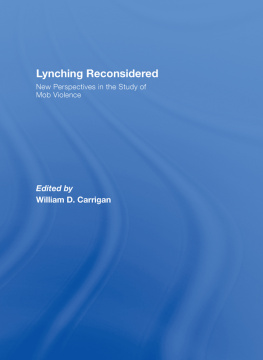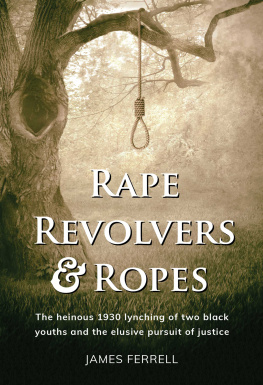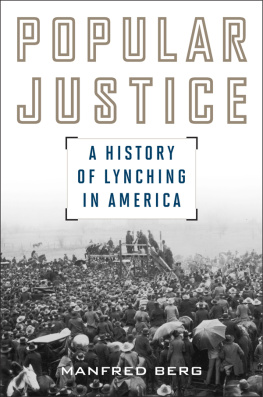Thank you for downloading this Scribner eBook.
Join our mailing list and get updates on new releases, deals, bonus content and other great books from Scribner and Simon & Schuster.
C LICK H ERE T O S IGN U P
or visit us online to sign up at
eBookNews.SimonandSchuster.com
We hope you enjoyed reading this Scribner eBook.
Join our mailing list and get updates on new releases, deals, bonus content and other great books from Scribner and Simon & Schuster.
C LICK H ERE T O S IGN U P
or visit us online to sign up at
eBookNews.SimonandSchuster.com
Acclaim for Fire in a Canebrake
Fire in a Canebrake is a rifle butt to the belly.... Wexler peels back the gray paint that tidies up our perception of ourselves.
The San Diego Union-Tribune
Wexler is a thorough reporter who has enough faith in the facts to let them tell the story. In instances where no facts or witnesses exist to support what appear to be obvious conclusions, she admirably backs off and avoids undue speculation... and persuasively establishes a context in which unspeakable monstrosities are not only condoned but even encouraged.
The Washington Post
The story Wexler tells... re-create[s] the atmosphere of fear and intimidation that blanketed Walton County after the lynchings, as well as the horrors of the event itself.
The Boston Globe
Wexlers portrayal... is fascinating because she transports us into a world... that is fortunately unknown to many readers.
San Francisco Chronicle
Any writer of nonfiction aims to pull the narrative as tautand provide as much useful informationas possible. In achieving both of these goals, Wexler offers a memorial worthy of Americas last mass lynching.
The Miami Herald
Wexlers sense of pacing and denouement is rousing, and her intricate, careful portrayal of the social settings and racial imaginations of the postWorld War II South are just as startling.
Publishers Weekly
Well-documented, well-written, and endlessly fascinating debut.
Kirkus Reviews
Wexler offers fresh insights into the histories of the victims and suspects in the crime. But in the end, whether out of stubbornness, resignation, or fear, no one seems much inclined to set the record straight. Those closest to the murders havent spoken for decadesand in those who havent already died, the truth most certainly has.
Mother Jones
This is Truman Capotes In Cold Blood with the added fuel of race, sex, and the quirks of Southern culture.
Juan Williams, author of Eyes on the Prize: Americas Civil Rights Years, 19541965
Fire in a Canebrake is so honest, so meticulous, so graceful in re-creating a tragedy, it somehow transcends the specific events of postwar rural Georgia and speaks instead, in some ineffable way, to Americas most enduring pathology. Four bodies fall in a quiet, barely marked placeand yet by the end of the tale, Laura Wexler has us thinking about the thousands lynched across the country, about law and sin, about complicity, corruption, and national denial. We begin to get clean when we begin to remember.
David Simon, author of The Corner: A Year in the Life of an Inner-City Neighborhood
A searing, masterfully written, meticulous work that shines a brutally honest light on a dark moment from our not-so-distant past.... Vivid, engrossing, and stunningly sad. A must-read.
David Isay, public radio producer and author of Flophouse: Life on the Bowery
Wexler restores an all-but-forgotten event to our memories and our bones. The detailsfrom the weave of the rope to what the victims ate that dayare so exact and terrible that I winced as I read.
Pagan Kennedy, author of Black Livingstone: A True Tale of Adventure in the Nineteenth-Century Congo
The power of history is its shelf life, its radioactivity once exposed to light. Laura Wexlers Fire in a Canebrake is an excellent case in point.
John Egerton, author of Speak Now Against the Day: The Generation Before the Civil Rights Movement in the South
Only a few daytime feet separated the consciences of the white lynchers from the four bound blacks they were eager to kill. And it is precisely in that tense space where Laura Wexlers disturbing account of the Moores Ford murders resides. In that terrifying and familiar place we call home.
James Allen, author of Without Sanctuary: Lynching Photography in America
Laura Wexlers insightful, well-researched account... is a stone that has long been missing from the edifice of modern Southern history.
Philip Dray, author of At the Hands of Persons Unknown: The Lynching of Black America
Wexler uncovers a tragedy most white Southerners would like to forget ever occurred. Wexler has done a great service.
Morris Dees, cofounder of the Southern Poverty Law Center
CONTENTS
FOR R.L.W. AND M.E.R.,
AND FOR MY PARENTS


In Young Funeral Home in Walton County, Georgia, friends and relatives view the bodies of the four victims of the Moores Ford lynching: (left to right) Roger Malcom, age twenty-four; Dorothy Malcom, age twenty; George Dorsey, age twenty-eight; and Mae Murray Dorsey, age twenty-three. ( Bettmann/Corbis)

And how do you reach the truth if lying has become a habit?
A RIEL D ORFMAN, AFTERWORD TO D EATH AND THE M AIDEN
CHAPTER ONE
I dont want any trouble, said the white man, Barnette Hester.
He stood on one side of the dirt road, and his two black tenants, Roger and Dorothy Malcom, stood on the other side. They were shouting and cursing, their voices echoing through the Sunday-evening quiet. The noise had reached Barnette Hester in the barn. Hed stopped in the middle of milking, run out to the road, and issued his warning.
At twenty-nine, Barnette Hester was tall and thin, so thin he appeared boyish, as though his body hadnt yet filled out. His three older brothers were broad-shouldered men who spoke in booming voices, but he, the youngest, was shy to the point of silenceexcept on Saturday nights, when he drank liquor and talked and laughed a little. Hed been born in the modest house across the road. When the other men his age went off to the war, he stayed home to help his parents, and his father made him overseer of the family farm. They owned one hundred acres: a few behind the house, and the rest beyond the barn. That afternoon, after returning from church, Barnette had walked through the rows of cotton and corn and reached the same conclusion as many of Walton Countys farmers: it was the beginning of lay-by time. The crops were nearly full grown, and fieldwork would be light for the next month or so, until the harvest.
When it was harvesttime, Barnette would work in the fields from sunup to sundown, snatching the cotton from the bolls and stuffing it into burlap croker sacks. And Roger and Dorothy Malcom would work alongside him. As children, Barnette and Roger had been playmates. But in January, when Roger and Dorothy moved onto the Hester farm, theyd become Barnettes tenants. Once, earlier in the spring, hed found them fighting in the road in front of his familys house and told them to go homeand theyd obeyed. Theyd walked to the fork in the road, taken the path down a small hill, and disappeared inside their tenant house. Barnette issued the same warning this evening, and he expected the same reaction.
Next page













